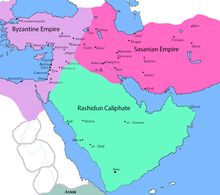
Back الفتح الإسلامي لفارس Arabic غزو المسلمين فارس ARZ Conquista musulmana de Persia AST موسلمانلارین ایران آلینماسی AZB Ғәрәптәрҙең Фарсияны яулауы Bashkir Арабскае заваяванне Персіі Byelorussian Арабско завоюване на Персия Bulgarian মুসলিমদের পারস্য বিজয় Bengali/Bangla Muslimansko osvajanje Perzije BS Conquesta musulmana de Pèrsia Catalan
The Muslim conquest of Persia, also called the Muslim conquest of Iran, the Arab conquest of Persia, or the Arab conquest of Iran,[2] was a major military campaign undertaken by the Rashidun Caliphate between 632 and 654. As part of the early Muslim conquests, which had begun under Muhammad in 622, it led to the fall of the Sasanian Empire and the eventual decline of Zoroastrianism, which had been predominant throughout Persia as the nation's official religion. The persecution of Zoroastrians by the early Muslims during and after this conflict prompted many of them to flee eastward to India, where they were granted refuge by various kings.
While Arabia was experiencing the rise of Islam in the 7th century, Persia was struggling with unprecedented levels of political, social, economic, and military weakness; the Sasanian army had greatly exhausted itself in the Byzantine–Sasanian War of 602–628. Following the execution of Sasanian shah Khosrow II in 628, Persia's internal political stability began deteriorating at a rapid pace. Subsequently, ten new royal claimants were enthroned within the next four years.[3] Shortly afterwards, Persia was further devastated by the Sasanian Interregnum, a large-scale civil war that began in 628 and resulted in the government's decentralization by 632.
Amidst Persia's turmoil, the first Rashidun invasion of Sasanian territory took place in 633, when the Rashidun army conquered parts of Asoristan, which was the Sasanians' political and economic centre in Mesopotamia.[4] Later, the regional Rashidun army commander Khalid ibn al-Walid was transferred to oversee the Muslim conquest of the Levant, and as the Rashidun army became increasingly focused on the Byzantine Empire, the newly conquered Mesopotamian territories were retaken by the Sasanian army. The second Rashidun invasion began in 636, under Sa'd ibn Abi Waqqas, when a key victory at the Battle of al-Qadisiyyah permanently ended all Sasanian control to the west of modern-day Iran. For the next six years, the Zagros Mountains, a natural barrier, marked the political boundary between the Rashidun Caliphate and the Sasanian Empire. In 642, Umar ibn al-Khattab, eight years into his reign as Islam's second caliph, ordered a full-scale invasion of the rest of the Sasanian Empire. Directing the war from the city of Medina in Arabia, Umar's quick conquest of Persia in a series of coordinated and multi-pronged attacks became his greatest triumph, contributing to his reputation as a great military and political strategist.[3] In 644, however, he was assassinated by the Persian craftsman Abu Lu'lu'a Firuz, who had been captured by Rashidun troops and brought to Arabia as a slave.
Some Iranian historians have defended their forebears by using Arab sources to illustrate that "contrary to the claims of some historians, Iranians, in fact, fought long and hard against the invading Arabs."[5] By 651, most of the urban centres in Iranian lands, with the notable exception of the provinces along the Caspian Sea (i.e., in Tabaristan and Transoxiana), had come under Muslim domination. Many localities fought against the invaders; although the Rashidun army had established hegemony over most of the country, many cities rose in rebellion by killing their Arab governors or attacking their garrisons. Eventually, military reinforcements quashed the Iranian insurgencies and imposed complete control. The Islamization of Iran was gradual and incentivized in various ways over a period of centuries, though some Iranians never converted and there were widespread cases of Zoroastrian scriptures being burnt and Zoroastrian priests being executed, particularly in areas that experienced violent resistance.[6] Islam had become Iran's predominant religion by the Late Middle Ages;[7][8] the majority of Iranians were Sunni Muslims until the Safavids forcefully converted Iran to Shia Islam in the 18th century.
- ^ Pourshariati 2008, pp. 469.
- ^ "ʿARAB ii. Arab conquest of Iran". iranicaonline.org. Archived from the original on 26 September 2017. Retrieved 18 January 2012.
- ^ a b The Muslim Conquest of Persia By A.I. Akram. Ch: 1 ISBN 978-0-19-597713-4
- ^ Stephen Humphreys, R. (January 1999). Between Memory and Desire. University of California Press. p. 180. ISBN 9780520214118 – via Internet Archive.
- ^ Milani A. Lost Wisdom. 2004 ISBN 978-0-934211-90-1 p.15
- ^ (Balāḏori, Fotuḥ, p. 421; Biruni, Āṯār, p. 35)
- ^ Mohammad Mohammadi Malayeri, Tarikh-i Farhang-i Iran (Iran's Cultural History). 4 volumes. Tehran. 1982.
- ^ ʻAbd al-Ḥusayn Zarrīnʹkūb (2000) [1379]. Dū qarn-i sukūt : sarguz̲asht-i ḥavādis̲ va awz̤āʻ-i tārīkhī dar dū qarn-i avval-i Islām (Two Centuries of Silence). Tihrān: Sukhan. OCLC 46632917.
© MMXXIII Rich X Search. We shall prevail. All rights reserved. Rich X Search
